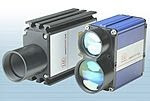Application of sound waves in technology
Sonar:
Sonar stands for SOund NAvigation Ranging. Sonar is used in navigation, forecasting weather, and for tracking aircraft, ships, submarines, and missiles. Sonar devices work by bouncing sound waves off objects to determine their location. A sonar unit consists of an ultrasonic transmitter and a receiver. On boats, the receiver is mounted on the bottom of the ship. To measure water depth, for instance, the transmitter sends out a short pulse of sound, and later, the receiver picks up the reflected sound. The water depth is determined from the time elapsed between the emission of the ultrasonic sound and the reception of its reflection off the sea-floor. In the diagram below, a ship sends out ultrasonic waves (green) in order to detect schools of fish swimming beneath. The waves reflect off the fish (white), and return to the ship where they are detected and the depth of the fish is determined.
Sonar stands for SOund NAvigation Ranging. Sonar is used in navigation, forecasting weather, and for tracking aircraft, ships, submarines, and missiles. Sonar devices work by bouncing sound waves off objects to determine their location. A sonar unit consists of an ultrasonic transmitter and a receiver. On boats, the receiver is mounted on the bottom of the ship. To measure water depth, for instance, the transmitter sends out a short pulse of sound, and later, the receiver picks up the reflected sound. The water depth is determined from the time elapsed between the emission of the ultrasonic sound and the reception of its reflection off the sea-floor. In the diagram below, a ship sends out ultrasonic waves (green) in order to detect schools of fish swimming beneath. The waves reflect off the fish (white), and return to the ship where they are detected and the depth of the fish is determined.

Radar
Radar is an object-detection system which uses electromagnetic waves— specifically radio waves — to determine the range, altitude, direction, or speed of both moving and fixed objects such as aircraft, ships, spacecraft, guided missiles, motor vehicles, weather formations, and terrain. The radar dish, or antenna, transmits pulses of radio waves or microwaves which bounce off any object in their path. The object returns a tiny part of the wave's energy to a dish or antenna which is usually located at the same site as the transmitter.


